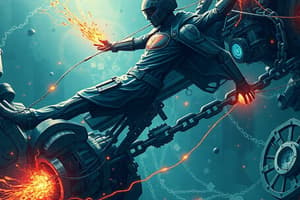Podcast
Questions and Answers
What is the equation for force according to the text?
What is the equation for force according to the text?
- $f = m + a$
- $f = m - a$
- $f = ma$ (correct)
- $f = m/a$
What are the two dimensions of force mentioned in the text?
What are the two dimensions of force mentioned in the text?
- Speed and time
- Weight and quantity
- Mass and velocity
- Magnitude and direction (correct)
Which type of force is described as the weight of a body segment?
Which type of force is described as the weight of a body segment?
- Gravity (correct)
- Muscles
- Externally applied resistance
- Friction
What does Newton's 1st law describe?
What does Newton's 1st law describe?
According to Newton's 2nd law, what does acceleration of an object depend on?
According to Newton's 2nd law, what does acceleration of an object depend on?
What does Newton's 3rd law describe?
What does Newton's 3rd law describe?
Which type of force provides force through a contraction or stretch?
Which type of force provides force through a contraction or stretch?
What is the study of forces acting on a body referred to as in the text?
What is the study of forces acting on a body referred to as in the text?
What is displacement defined as in the text?
What is displacement defined as in the text?
Which equation represents the relationship between force, mass, and acceleration?
Which equation represents the relationship between force, mass, and acceleration?
Which of the following is a passive restraint affecting the body's response to forces?
Which of the following is a passive restraint affecting the body's response to forces?
What defines the class of a lever in biomechanics?
What defines the class of a lever in biomechanics?
What is the theoretical point around which the mass of an object is balanced known as?
What is the theoretical point around which the mass of an object is balanced known as?
What characteristic of skilled performance in many sports can be affected by inertia and body movement?
What characteristic of skilled performance in many sports can be affected by inertia and body movement?
What is used to measure and calculate forces, ground reaction forces, and pressure on joints in biomechanical analysis and clinical applications?
What is used to measure and calculate forces, ground reaction forces, and pressure on joints in biomechanical analysis and clinical applications?
Which of the following affects joint protection, movement ease, and skilled performance in sports?
Which of the following affects joint protection, movement ease, and skilled performance in sports?
What law do ground reaction forces follow?
What law do ground reaction forces follow?
What changes with movement and differs between men and women due to body structure?
What changes with movement and differs between men and women due to body structure?
What can create rotary motion at a joint and affect the difficulty of lifting a force?
What can create rotary motion at a joint and affect the difficulty of lifting a force?
Which of the following can cause deformation or injury on the body?
Which of the following can cause deformation or injury on the body?
Flashcards are hidden until you start studying
Study Notes
Forces, Levers, Moments, Center of Mass, and Instrumentation in Biomechanics
- Forces acting on the body can cause deformation or injury, such as compression, tension, shear, torsion, bending, and combinations of these forces.
- Musculoskeletal forces include compression, tension, shear, torsion, bending, and combination forces.
- Passive restraints like ligaments and joint capsules, as well as external forces like gravity and physical contact, affect the body's response to forces.
- Levers in biomechanics have three classes, with the order of elements defining the class: Class 1 has the fulcrum in the middle, Class 2 has the resistance in the middle, and Class 3 has the effort in the middle.
- Moments and torque play a crucial role in biomechanics, affecting the difficulty of lifting a force and creating rotary motion at a joint.
- The center of mass (COM) is a theoretical point around which the mass of an object is balanced, and it changes with movement; it is also known as the center of gravity (COG).
- Center of gravity (COG) differs between men and women, with men having a more superior COG due to broader shoulders, and women having a lower COG due to broader hips.
- Angular velocity, the rate of rotation of a body segment, is a characteristic of skilled performance in many sports and can be affected by inertia and body movement.
- Instrumentation such as force transducers and force plates are used to measure and calculate forces, ground reaction forces, and pressure on joints, aiding in biomechanical analysis and clinical applications.
- Pressure, normal stress, pulleys, and ground reaction forces play significant roles in biomechanics, affecting joint protection, movement ease, and skilled performance in sports.
- Ground reaction force (GRF) follows Newton's third law and changes in magnitude, direction, and point of application through the stance phase of ground exertion, affecting gait and stability.
- Biomechanics is a complex field where the understanding of forces, levers, moments, center of mass, and instrumentation is crucial for analyzing human movement and optimizing performance.
Studying That Suits You
Use AI to generate personalized quizzes and flashcards to suit your learning preferences.




